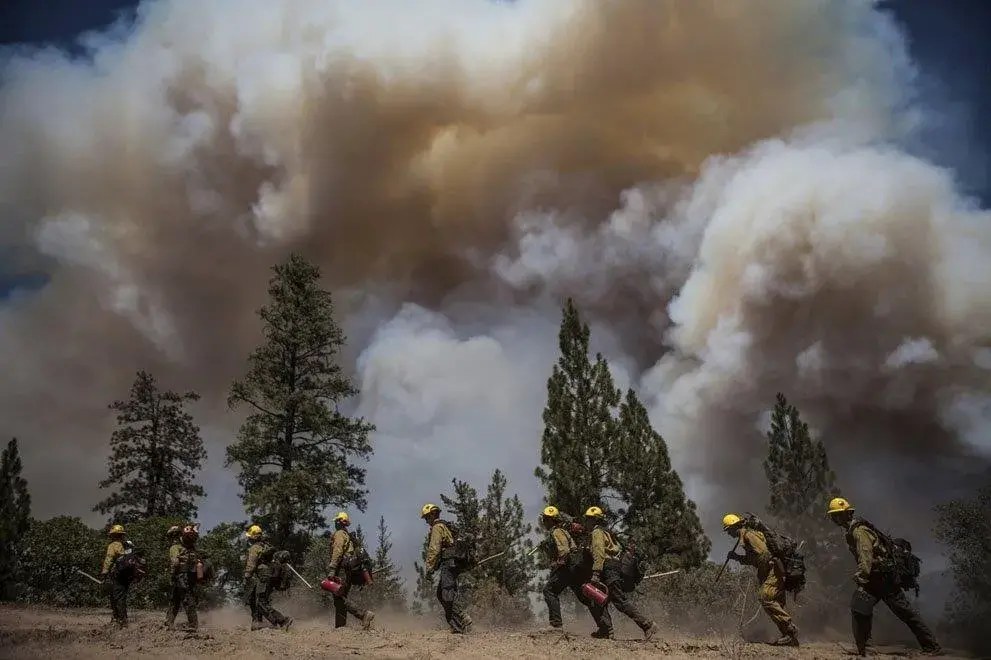The Department of Homeland Security (DHS) Science and Technology Directorate (S&T) recognizes the struggle for wildland firefighters as they try to achieve a balance of personal protective clothing and heat safety.
 The heat of the summer months add danger for wildland firefighters tasked with extinguishing blazes. Although their protective gear may offer protection from the thermal exposure risks of firefighting, the layers of personal protective equipment (PPE) can increase a firefighter’s body temperature to hazardous levels.
The heat of the summer months add danger for wildland firefighters tasked with extinguishing blazes. Although their protective gear may offer protection from the thermal exposure risks of firefighting, the layers of personal protective equipment (PPE) can increase a firefighter’s body temperature to hazardous levels.
Extreme heat becomes lethal when the human body faces conditions of high temperatures and humidity and subsequently struggles to sustain the normal temperature of 98 degrees Fahrenheit. The general term used for heat disorders is hyperthermia. Onset usually appears in three common forms: heat cramps, heat exhaustion, and heat stroke. For firefighters, the strenuous work of combatting fires in locations ranging from dense cities, where asphalt retains heat thereby creating the urban heat island effect, to rural wildfires, which require long hours to control and contain blazes, heightens the need to take precautions.
Overexertion, stress, and medical conditions accounted for nearly 60 percent of firefighter deaths in 2015. Fatalities from sudden cardiac arrest ranked at 51 percent. A 2008 study by the Firefighter Life Safety Research Center at the University of Illinois at Urbana-Champaign concluded that fatalities from heart attacks, slips, trips, and falls appear to be linked to heat stress, a situation that might be alleviated by reconfiguring and enhancing firefighter PPE.
Depending on the age and overall physical fitness of each firefighter, precautions can be difficult to enforce during a chaotic and often unpredictable emergency response. Initial steps for treating someone with hyperthermia include moving the patient to a cooler location and providing the patient with cool water or liquids that contain electrolytes.
The California Department of Forestry and Fire Protection (CAL FIRE) stressed the importance of this problem as firefighters battling wildfires in the state succumbed to heat stress at a higher rate than those afflicted with burn injuries. CAL FIRE requested S&T explore options for developing new PPE garment ensembles for wildland firefighters.
A major concern for developing the new PPE was the need to increase the protection, safety, and comfort for wildland firefighters while lowering the danger of heat exhaustion. This was the primary goal of DHS S&T’s Advanced Personal Protection System (APPS) Project which teamed with the U.S. Army Natick Soldier Research, Development & Engineering Center.
Known as the Wildland Firefighter Advanced Personal Protection System (WLFF APPS), the garment system improved the form, fit, and function of protective layers. It uses material with high heat loss properties to reduce core-body temperatures sustained during work rates consistent with those experienced during wildfire scenarios.
William Deso, the project manager for the APPS Project said, “The WLFF APPS strikes a balance between protection against burn injuries and comfort for the wearer. The design of the garments was based on input from wildland firefighters to better meet the operational requirements of fighting wildland fires. We believe that the WLFF APPS ensemble is a great improvement for the safety and comfort of the wildland firefighters.” The WLFF APPS final report describing the performance of appropriately 1,000 garment ensembles that were operationally wear tested by wildland firefighters during two wildland fire seasons was published in 2014.
The WLFF APPS prototype garments were certified to the National Fire Protection Association (NFPA) 1977 standards that outline specific performance parameters for wildland firefighting garments. The NFPA 1977 criteria include total heat loss, thermal stability, heat and thermal shrinkage parameters.
As firefighters continue to battle wildfires, the unseen threat of heat exhaustion will remain a significant danger to their safety. It is the goal of S&T that the performance of future firefighter PPE and respiratory protection equipment will continue to improve protection against both seen and unseen dangers.
For more information on firefighter PPE under development, please contact first.responder@hq.dhs.gov.
